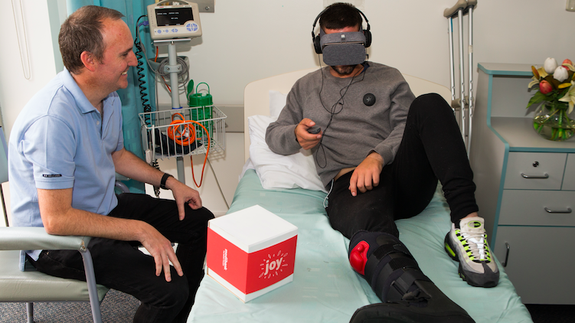Virtual reality aims to transport lonely patients out of the hospital bed

Virtual reality may be struggling to crossover into the gaming mainstream, but doctors are excited about the role it could play in medical treatment and therapy.
In 2016, VR let clinicians step into a cancer cell, and now an immersive experience named Joy is being tested for its ability to alleviate loneliness among long-stay hospital patients.
SEE ALSO: 'The Martian VR Experience' comes to PlayStation VR and HTC Vive
Built by Australian VR company Liminal and commissioned by the health insurer Medibank, it aims to provide a comforting experience for those who are unable to leave their hospital bed.
Medibank's chief medical officer, Linda Swan told Mashable there's an emerging body of evidence that links loneliness to increased risk of disease and even slower recovery times.
"We know it's more common for people in hospitals," she said. "We wanted to find a way to do something in the hospital setting to alleviate that feeling."
In the experience, cartoon figures sit in a circle around a campfire. Using Google Daydream View and its hand controller, the user can select a story from a book, which one of the characters will then read aloud.
Sami Yamin, neuroscientist and head of research at Liminal, said he hopes the campfire setting will be escapist. "Campfires are where communities gather," he said, "We wanted them, for a short time, to really leave ... their hospital environment."
Tests with patients have now begun at Brunswick Private Hospital in Melbourne, Australia.
If you've had the chance to try a VR experience on the HTC Vive headset or a fully-fledged VR game, Joy feels fairly rudimentary in its graphics and level of interactivity.
While she acknowledged the experience was somewhat childlike, Swan said they tried to appeal to the broadest number of people possible.
Yamin also pointed out that it's intended for people who are mostly bed-bound, so any interactivity had to work within a small range of movement. "We were mindful there are limitations on the hospital patients and what they can do," he said. "We did not want to have them limited by any specific pain or limited movement."
That's also why the team chose to use mobile VR over room scale VR, as well as the Daydream headset over other smartphone-enabled VR headsets.
"The other portable [headsets] are really uncomfortable, or you have to be tapping the side of your head all the time," he said. "If someone just had shoulder reconstruction, you still want them to be able to use the experience."
Beyond Joy, Yamin sees huge potential for VR. "I think VR is going to have a massive impact on the medical profession," he said. "Assessment and early diagnosis, to rehabilitation and ongoing recovery and pain management."

Image: medibank
But while room-scale VR is great in a clinical setting, he suggested the technology so far has been too expensive or inaccessible for common use in clinics or hospitals.
There's also limited amount of appropriate content — something he hopes to change.
"The only limitation is how researchers can interact with the developers. Getting closer synergy will make all the difference," he said.
After the trial, Medibank will decide if the program should be rolled out more broadly as part of its range of health services.
"This is the the first VR tool that we're trying," Swan said. "We're doing remote monitoring as well. This is just one example of us looking at how technology can help members manage their health."
